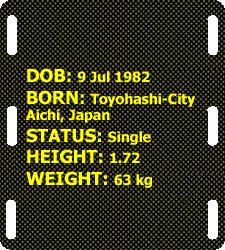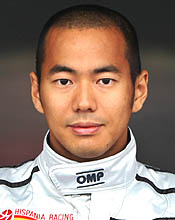|
Sakon began his motorsport career in 1994, when he enrolled at the Suzuka Kart Racing School.
Over the next six years he honed his skills, contesting various Karting championships, mostly in Japan, but then, as he improved, in Europe. Along the way, he won a number of regional titles and even the Japan Kart Championship (FA Class) in 1999.
Although he completed a single-seater course at Suzuka in 2000, it wasn't until the following year that actually moved up to formula racing.
In 2001, Sakon had a tough schedule. In addition to contesting the Japanese F3 Championship (finishing fourth overall), he also took part in two rounds of the British F3 Championship (Brands Hatch an Silverstone), as well as the Marlboro Masters at Zandvoort and the Macau Grand Prix.
In 2002 he contested the German F3 Championship, moving up to the F3 Euroseries a year later.
In 2004 he returned to Japan, racing in the Japanese F3 Championship, once again, switching to the Formula Nippon Series in 2005.
2005 also saw Sakon make his F1 debut, giving a credible performance at Suzuka, where - for a modest fee - he was employed by Jordan as its Friday driver.
When Super Aguri's Yuji Ide had his licence revoked by the FIA after the first four races of 2006 , the Japanese team was eager to recruit another 'home grown' talent, consequently Sakon got the call, joining the team as Friday driver at Silverstone.
Making his race debut at Hockenheim, the 24-year-old suffered a driveshaft failure on the first lap. Due to spins and other failures, after four Grands Prix poor Sakon had completed just 42 laps.
That said, he finished the three remaining races, and even posted the seventh fastest race lap at Interlagos, so there's no doubting his speed.
When Super Aguri finalised its line-up for 2007, Sakon was named as test driver, along with Giedo van der Garde.
However, when Christijan Albers was dumped by Spyker after the British Grand Prix, it was Sakon who got the call to replace him from the Hungarian race onwards. (Markus Winkelhock replacing Albers at Hockenheim).
Despite a somewhat shaky start, Sakon soon got to grips with the F8-VII, and it wasn't too long before he was actually giving his teammate, Adrian Sutil, a run for his money. At season end, Mike Gascoyne admitted the team had been "very impressed" with the Japanese youngster, citing his "good work ethic".
Just a few days after the launch of the R28, Renault's 2008 contender, the French team announced that Sakon would be joining as test driver, alongside Lucas di Grassi and Romain Grosjean. The reality being that the Japanese driver would be mainly involved with the team's highly popular 'Roadshow' programme.
In 2008 Sakon contested the second half of the GP2 championship with ART Grand Prix but with little success, remaining with the French outfit for the GP2 Asia series.
Having done noting of any consequence in 2009 it came as something of a surprise when Sakon was announced as test and reserve driver for Hispania on 17 April 2010.
However, there was an even bigger surprise just three months later when Colin Kolles announced that the Japanese driver would replace Bruno Senna for the British Grand prix. Despite retiring after 19 laps, Sakon contested six more races, this time replacing Karun Chandhok.
It would be totally unfair to pass comment on Sakon's performances in 2010, especially when one considers the equipment at his disposal. That said, we hope he and his backers feel they got good value for their money, though somehow we doubt it.
Statistics - at the end of 2010 Season
Drivers' Titles: 0
Seasons in F1: 3
Grand Prix: 21
Wins: 0
Points: 0
Poles: 0
Fastest Laps: 0
Best result in 2010: 15th (Korea)
Best qualifying 2010: 21st (Belgium)
Worst qualifying 2010: 24th (4 times)
2010: Out-qualified Karun Chandhok 0 times
2010: Out-qualified Bruno Senna 1 time
2010: Out-qualified by Karun Chandhok 1 time
2010: Out-qualified by Bruno Senna 5 times
2010: Completed 331 out of 394 laps (84%)
2010: Finished 6 times from 7 starts (86%)
|
























